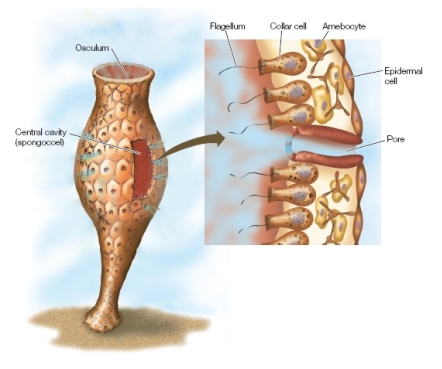Multiple Choice
Refer to the figure below.  The figure shows a simple sponge that lives attached to the ocean floor.The sponge consists of an outer layer of epidermal cells, an inner layer of collar cells and amebocytes, and pore cells that allow water to move from the outside to the inside.The water is propelled by the beating of flagella attached to the collar cells on the inside cavity.Collar cells trap food particles that are digested by the amebocytes.A student claims that a simple sponge could be a model organism used to study how multicellular organisms evolved.Which statement best evaluates this student's claim?
The figure shows a simple sponge that lives attached to the ocean floor.The sponge consists of an outer layer of epidermal cells, an inner layer of collar cells and amebocytes, and pore cells that allow water to move from the outside to the inside.The water is propelled by the beating of flagella attached to the collar cells on the inside cavity.Collar cells trap food particles that are digested by the amebocytes.A student claims that a simple sponge could be a model organism used to study how multicellular organisms evolved.Which statement best evaluates this student's claim?
A) The student's statement is correct because the sponge lives attached to the ocean floor and would therefore be a model for multicellular plant evolution.
B) The student's statement is correct because the sponge demonstrates a simple structure made up of cells that have specialized to serve different functions.
C) The student's statement is incorrect because the sponge does not have any recognizable organs or organ systems.
D) The student's statement is incorrect because the sponge has only four different types of cells while other multicellular organisms have many more.
E) The student's statement cannot be evaluated, because there is not enough information to support or refute the claim.
Correct Answer:

Verified
Correct Answer:
Verified
Q225: Which is an example of science?<br>A) An
Q226: In the names of organisms, the _
Q227: The three major groups of multicellular eukaryotes
Q228: Pesticides are not used in organic farming,
Q229: Species are given a distinctive scientific name
Q231: Which group is most distantly related to
Q232: Which is not a characteristic of most
Q233: A biologist hypothesizes that the sounds made
Q234: A researcher poses the hypothesis that plants
Q235: The seed of a desert plant may